


| Insect | Location | Nesting Habits | Diet | Rarity in Wisconsin | Do they sting? |
|---|---|---|---|---|---|
| European Paper Wasp | Europe, North America | Nests made of paper, typically found in trees or shrubs | Insects, nectar | Uncommon | Yes |
| Paper Wasp | North America | Nests made of paper, typically found in trees or shrubs | Insects, nectar | Common | Yes |
| Yellow Jacket | Worldwide | Underground nests or above-ground nests in trees or shrubs | Insects, fruit, nectar | Common | Yes |
| Mining Bee | Worldwide | Underground nests | Nectar, pollen | Common | No |
| Carpenter Bee | Worldwide | Nest in wood, often in abandoned carpenter bee nests | Nectar, pollen | Common | No |
| Mud Dauber | Worldwide | Nests made of mud, often found on walls or eaves of buildings | Insects, nectar | Uncommon | No |
| Bald Faced Hornet | North America | Nests made of paper, typically found in trees or shrubs | Insects, nectar | Common | Yes |
| Asian Beetle | Asia | Varies by species | Varies by species | Rare | No |
| Boxelder Bug | North America | Typically not social, do not build nests | Sap from boxelder trees | Common | No |
| Stink Bug | Worldwide | Typically not social, do not build nests | Plant material, occasionally insects | Common | No |
| Cluster Fly | Worldwide | Typically not social, do not build nests | Pollen, nectar | Common | No |
| Honey Bee | Worldwide | Nests made of wax, typically found in trees or man-made hives | Pollen, nectar | Common | Yes |
| Bumblebee | Worldwide | Nests made of wax and pollen, typically found underground | Pollen, nectar | Common | Yes |
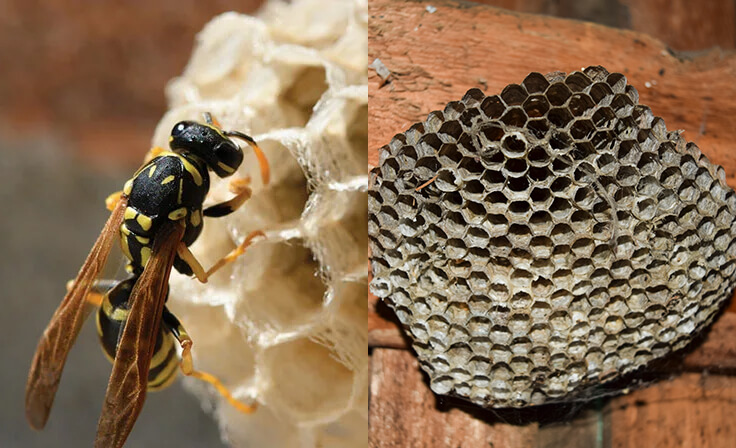
The Invasive European Paper Wasp is often mistaken for a Yellow Jacket. A closer look reveals it is larger than an average Yellow Jacket and has a much slimmer waist.
The nest of the European Paper Wasp may be built out in the open, however, this insect prefers to put its nest in cavities, such as rain gutters, downspouts, plumbing vents, birdhouses, pipes, hollow logs or trees, and the like. Nests are commonly found in mailboxes and car mirrors.
Because of its propensity to nest in enclosed areas, the European wasp has become a threat to cavity-nesting birds in North America and a danger to humans who might come upon a hidden nest or reach into something with one in it.
The European Paper Wasp is more aggressive than our native species of wasps. The older species are being displaced and replaced by this new non-native species. They get an earlier start in Spring and have been known to overtake newly built nests and kill the native Queens.
Every attempt should be made to limit suitable nest sites. Repair holes in walls, caulk cracks in soffits and eaves, and screen vents and louvers. Nests made early in the season by founding queens are easier to eliminate before workers are produced.
Proper identification of your pest and prevention of new nests are key.
The colonies are annual.
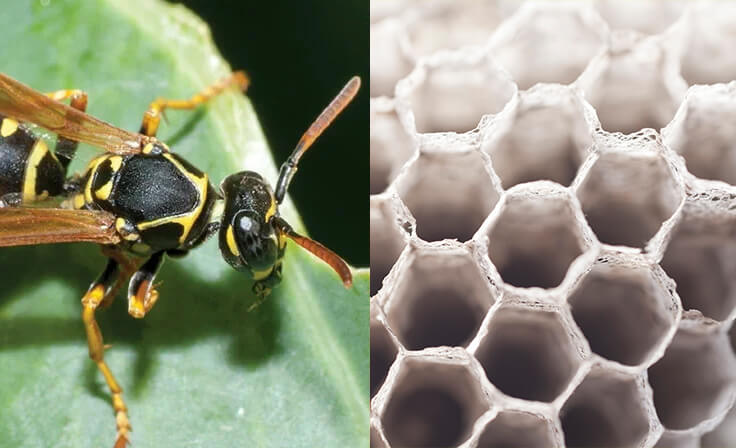
Paper wasps have a segmented body, a slower flight pattern and dangling legs. They are about 3/4" long and have a slim body.
Surprisingly, the most painful "bee" sting doesn't even come from a bee at all. Wasp stings are far worse than bees. Bees are reluctant to sting because they can only sting once. Wasps sting repeatedly.
Paper Wasps prefer nesting in attics but will nest practically anywhere; in eave peaks, behind shutters, under deck railings, in gas grills, swing sets, mailboxes, and light fixtures. Their nests aren't very large and can be tucked into any little nook or cranny.
The colonies are annual.
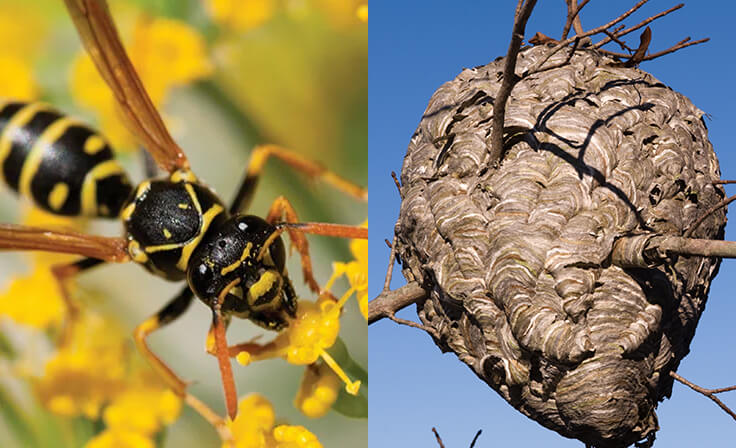
German Yellow Jackets are often mistaken for bees because they buzz like bees. Unlike a honeybee, which stings only once, a yellow jacket can sting repeatedly and the colonies are annual. They belong to a group of social wasps that cooperate to build and defend their queen and colony.
Aerial Yellow Jackets nest in trees, shrubs, under decks, or high in the eaves, their nest is very visible and easy to identify; a "football" or upside down teardrop-shaped nest constructed from gray paper with a single hole on the bottom.
Yellow Jackets actually make this paper themselves by chewing on tiny slivers of wood. The young are hatched and food is stored in the nest's center or "core" of hexagonal (or six-sided) cells. See picture at the left.
When Yellow Jackets nest inside a structure (such as your home) the nest is not at all visible. You'll see them flying in and out at some small gap, crack, or crevice on the exterior of your house. Note: Please do not seal this entrance hole shut.
You may even be able to hear yellow jackets inside. Listen to your wall or ceiling for a crackling, tickling, "rustling-leaves" sound. Those are yellow jackets going about the business of building their hive and slowly chewing through your plaster or drywall to expand their nests.
Have you ever been mowing the grass and been chased off your mower? Those were Ground Bees (actually a type of yellow jacket) that chased you in the house. They build hives two inches to two feet underground often using abandoned rodent burrows. They are much smaller than other yellow jackets but will aggressively defend their home.
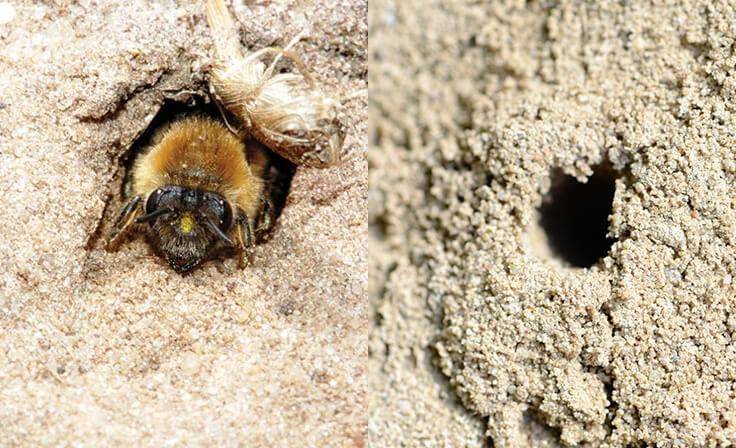
Mining bees resemble the typical honeybee in shape and size. Bodies are colored dark with fine light brown or yellow hairs. Andrenid bees have chewing-lapping mouthparts used to manipulate and collect flower products such as nectar and pollen. The protruding 'lapping' mouthpart is shorter in mining bees than honeybees giving them the common name of short-tongued bees.
Unlike honeybees, mining bees are solitary and do not form large, socially organized nests. As their name suggests, mining bees dig single nests in the soil. In spring, adult bees emerge, mate and begin nest preparation. Bees select exposed, well-drained soils to nest in such as banks, hills and road cut-outs. Although the bees are solitary nesters, they often construct nests in large numbers next to one another at a given nesting site. Each female mines out a cylindrical hole to raise offspring. The nest consists of a vertical tunnel and side cells alongside the tunnel for hatching eggs. Foraging activity generally lessens during the summer months and the bees become less noticeable. Mature larvae pupate and transform into adults during the late summer. Adults spend the winter inside the burrow and will emerge the following spring to start the whole cycle over.
When bees nest together in large numbers, they can be quite ominous, especially during mating and foraging seasons. Mining bees can sting only once and they are not easily provoked unless you run over their nest with a lawnmower.
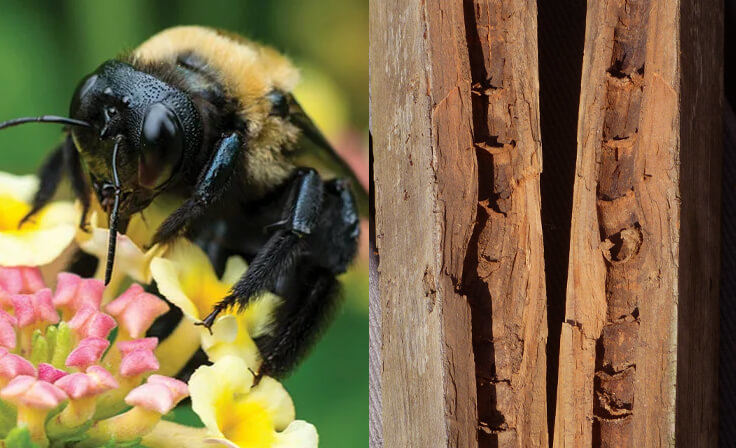
In the late spring and early summer, homeowners often notice large, black bees hovering around the outside of their homes. These are probably Carpenter Bees searching for mates and favorable sites to construct their nests. Male carpenter bees are quite aggressive, often hovering in front of people who are around the nests. The males are harmless because they lack stingers. Female carpenter bees can inflict a painful sting but seldom will unless they are handled or provoked.
Carpenter bees resemble bumblebees, but the upper surface of their abdomen is bare and shiny black. Bumblebees have a hairy abdomen with some yellow markings. Carpenter Bees can be found under eaves, decks, breezeways, etc. They drill holes in the exterior of the wood to lay eggs.
We do not exterminate carpenter bees.
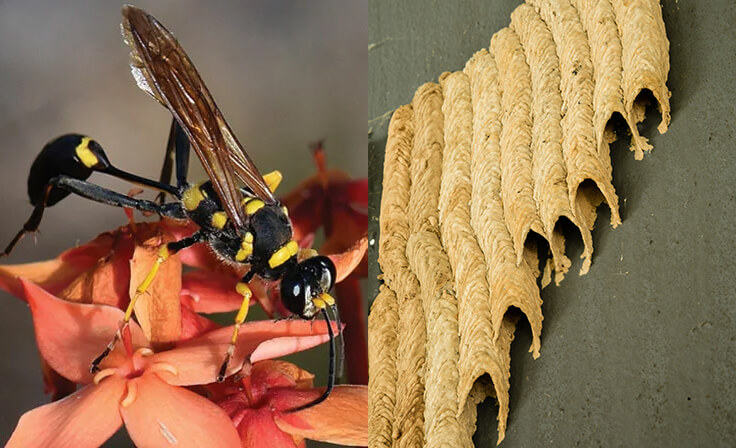
Mud Dauber wasps are not social wasps like paper wasps. They are in a different family.
The adult wasp puts a paralyzed spider or worm in each mud cell, which is built to enclose eggs, larvae and pupae. The mud cells form long clay tubes or large lumps.
The wasps are slender; they are shiny black, brown, orange and yellow. Many have long slender thread waists.
Like carpenter bees, Mud Daubers have no social caste structure. These wasps are not aggressive and will not sting unless pressed or handled, however, they do sting repeatedly.
Mud Daubers place their mud nests in protected places like electric motors, sheds, attics, against house siding and under porch ceilings. The nests are long tubelike structures. They also love soffits and hidden places as well.
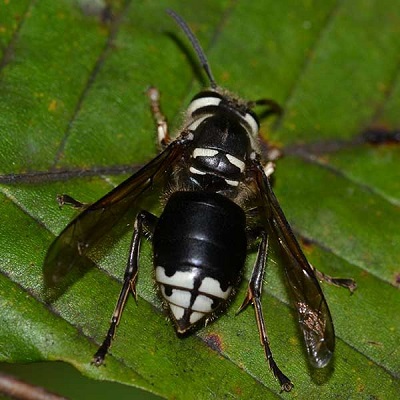
Bald-face hornets are certainly the strongest stinging insect I encounter on the job. They are the only ones able to sting directly through my protective clothing. They can even shoot venom into my eyes if they make it past the protective netting covering my face.
Hornets nests are entirely exterior -- trees, shrubs, under decks, and high in the eaves. They construct a "football" or upside-down teardrop-shaped nest from gray paper. Hornets, as do wasps and yellow jackets, make this paper themselves by chewing on tiny slivers of wood. The young are hatched and food is stored in the center of the nests' hexagonal cells. Hornet nests contain thousands of insects that are extremely aggressive when disturbed. The nests are often located out of reach and removal is best accomplished by a professional pest control firm. Unlike Bees, they can sting repeatedly. They build colonies annually.
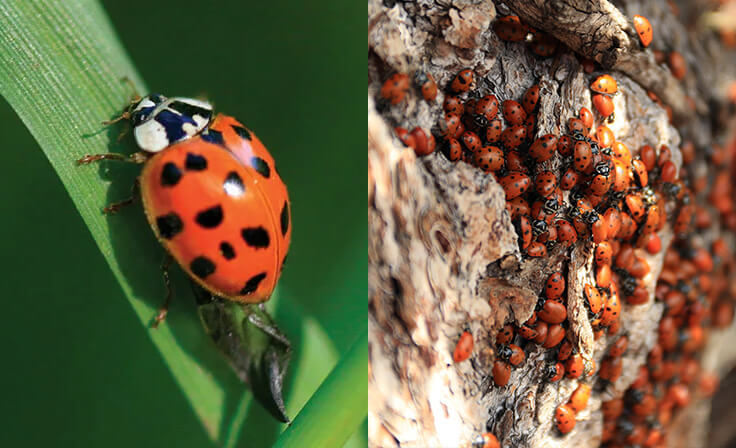
Preparation is key when it comes to Asian beetles. A properly timed exterior insecticide treatment can eliminate any infestations. Once the insects are in the house all you can do is vacuum them up. Never spray insecticides inside the house because they do not reproduce once inside.
During late winter or early spring, barrier treatments are ineffective because the beetles gained entry the previous autumn. Consider treatment before this happens.
To be effective, barrier treatments should be applied before the beetles enter buildings over winter. In Wisconsin, the proper timing for such treatments is early September thru the end of October.
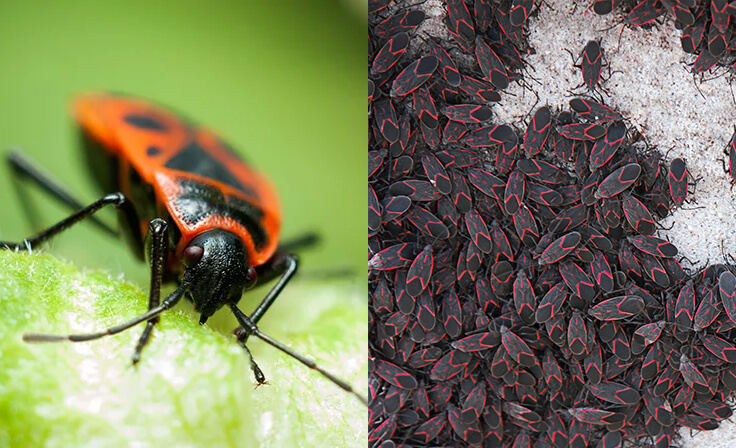
Boxelder bugs are bright red or black with narrow reddish lines on the back. They feed principally by sucking juices from the Boxelder tree, but are sometimes found on other plants. Boxelder bugs build up a large population and then invade a home. They are usually pests only by their presence, although their piercing-sucking mouthparts can sometimes puncture skin and cause irritation. Boxelder bugs do very little damage to the trees they attack. Adult Boxelder bugs will enter structures in the fall, seeking winter shelter. Once Boxelder bugs have invaded a home, there aren't many treatment options. The trusty vacuum cleaner is the best option by that point. It is important to consider treatment before this happens.
To be effective, barrier treatments should be applied before the bugs enter buildings over winter. In Wisconsin, the proper timing for such treatments is typically late-September thru the end of October although the optimal period will vary with seasonal conditions.
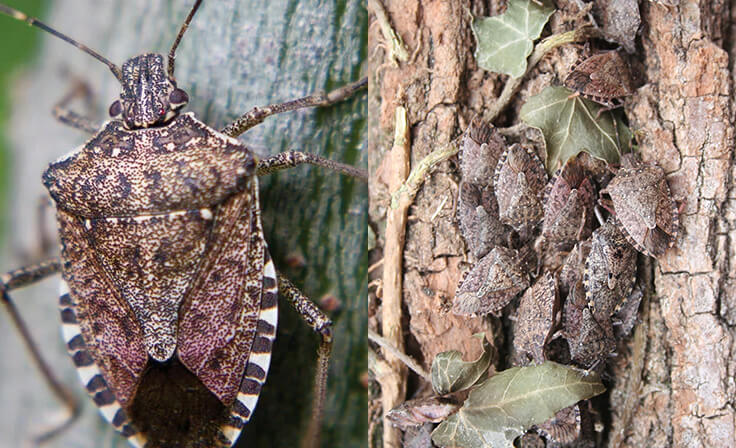
The United States is home to dozens of kinds of native stink bugs. They are not the problem. A new species arrived from Asia sometime in the late 1990s. It’s called the brown marmorated stink bug, or BMSB, and it is new to Wisconsin in the last couple of years.
Stink Bugs will enter structures in the fall, seeking winter shelter. Once the Stink Bugs have become established in the home, there aren't a lot of treatment options. If stink bugs have already found an entryway, use a vacuum cleaner to eliminate live and dead bugs. However, empty the vacuum cleaner or dispose of the bag immediately to prevent their odor from permeating in the area. Seal contents from the vacuum in a plastic bag and dispose of it with your normal garbage. Some have compared the odor to rotting almonds, rotting coconuts or rancid cinnamon.
It is important to consider prevention strategies before these pests invade your home.
To be effective, barrier treatments should be applied before the bugs enter buildings over winter. In Wisconsin, the proper timing for such treatments is typically late-September thru the end of October although this will vary with seasonal conditions.
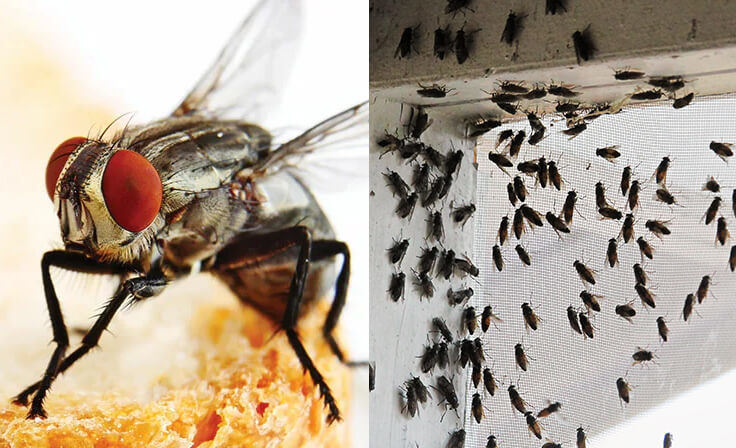
The Cluster Fly is a parasite of earthworms and breeds outdoors in lawns and fields during the spring and summer. You can find cluster flies almost everywhere in the United States and Canada, except for the Southern states bordering the Gulf of Mexico. When fall approaches, the cluster flies begin to enter structures in large numbers. Problems with cluster flies begin in late August as they begin to seek shelter for winter. The cluster fly is seeking warm sites with protective cracks for shelter, crawling back as far as they can get. It is important to consider treatment before this happens.
To be effective, barrier treatments should be applied before the flies enter buildings over winter. In Wisconsin, the proper timing for such treatments is typically late-September thru the end of October although this will vary with seasonal conditions.

Honey bees may establish a nest inside the wall of the house or other buildings causing a problem, a health hazard and a serious danger to the structure. Honey bees can only sting once before dying, making them reluctant to sting unless attacked.
Honey bee colonies in walls or attic voids are a more serious problem than yellowjacket wasps. Yellowjacket colonies are annual and the wasps will disappear in the winter with or without treatment. Honey bee nests may last for many years without treatment and will contain honey stored inside the walls. The honey can ruin walls and ceilings if not removed.
Combs inside buildings can also attract other bees and pests in the future. Controlling honey bee nests can be challenging. Call a pest control specialist if you spot bees around or coming out of your home.
We do not exterminate honey bees.

Bumblebees are social insects that live in colonies. Each spring a queen that has survived winter will find a suitable nesting site and establish her colony.
The bumblebee colony grows larger over the summer and is usually discovered while gardening or mowing the lawn. The bumblebees will attack to defend their nest, making them a health concern. They are pollinators and should only be exterminated if in an undesirable location. Unfortunately, they often build their nests under concrete by patios and steps. In that case, extermination is the only option. Bumble Bees are reluctant to sting, however, they will vigorously defend their nest.
Often confused with carpenter bees, bumblebees are characterized by the hairiness of the abdomen (carpenter bees have a smooth abdomen).
We do not exterminate bumblebees.


